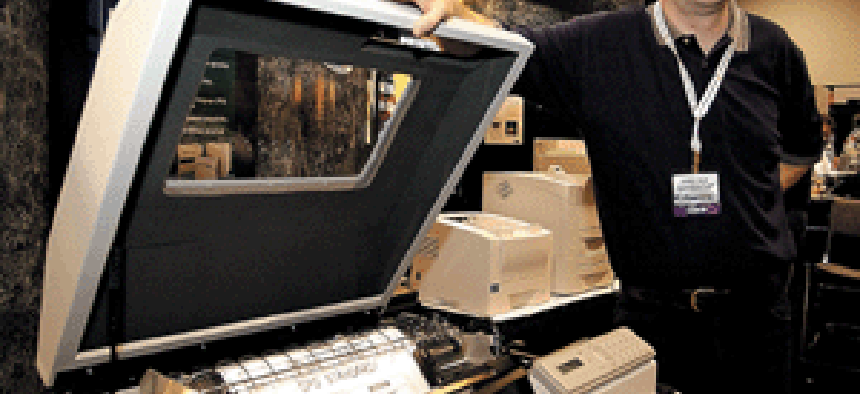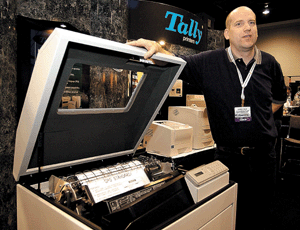Firms put innovation on display

Potential buyers of wireless solutions abounded at the 27th annual FOSE government IT trade show, but industry observers said many parties still hesitated to purchase them, citing inadequate security guidance from their agencies.
Potential buyers of wireless solutions abounded at the 27th annual FOSE government IT trade show, but industry observers said many parties still hesitated to purchase them, citing inadequate security guidance from their agencies. "There still needs to be clarification as to which agency policies apply to users. There is still a certain lack of clarity," said Sonya Verheyden, a manager of government channels and marketing for two-way paging device manufacturer Research in Motion Ltd. of Waterloo, Ontario. "A lot of what we have been doing [at the FOSE show] is education." Still, wireless vendors, like other companies, were out in force at FOSE, showing off new products at the show, held April 8-10 at the new Washington Convention Center. FOSE is produced by PostNewsweek Media Inc., publisher of Washington Technology. On the wireless front, Intermec Technologies Corp., Everett, Wash., demonstrated its new 700 series of mobile computers, which can communicate wirelessly in three different formats: wide area network, personal area network and local area network protocols, according to Kris Fouts, a marketing and communications manager for the company.Care Fusion Inc., McLean, Va., was showing its wireless-based, nursing workflow solution. It allows nurses to keep track of patient medications and vital statistics using bar codes, which patients wear on wristbands and are scanned by portable digital assistants. The Department of Veterans Affairs uses the solution in five hospitals, said Chris Hill, vice president of marketing for the company. VA seems to be one of the early adopters of wireless. Another exhibitor, Fortress Technologies Inc., Oldsmar, Fla., is about half way through an agencywide implementation of its wireless security solution for VA, said David O'Brien, director of civilian government sales for the company. The VA dispenses medication using mobile carts that are wirelessly connected to servers that send and receive patient information, O'Brien said. The security solution that Fortress provides the VA's hospitals was acquired through PlanetGov Inc., Chantilly, Va., under the second iteration of VA's Procurement of Computer Hardware and Software contract. O'Brien said the sale was worth more than $1 million.Fortress' solutions consist of client software for each of the handheld and gateway appliances that the devices communicate with. Fortress' solution is unique in that each encrypted transmission packet is given a pseudo-Media Access Control address. Most network devices come with fixed, unique MAC addresses. As a result, even if an eavesdropper is able to intercept a packet and break its encryption, he won't be able get any information from the packet headers that will allow access to the network, O'Brien said.In addition to wireless, network equipment providers are seeing new markets in fiber-optic-based networks. While used extensively for long-distance communications, companies are seeing more agencies using the technology for wiring offices and work campuses. Such installations can give offices high-throughput data networking alternatives to coaxial cables or twisted pair telephone lines."We're seeing more fiber-optic installations," said Jay Williams, market manager for the new federal government division of cable product vendor CommScope Properties, Hickory, N.C. The company formed a partnership with cabling installation company Siemon Co., Watertown, Conn., to offer physical cable installations for agencies and integrators.John Hines, southeast regional sales manager of Sumitomo Electric Lightwave Corp., Research Triangle Park, N.C., said his company is targeting the emerging market for fiber-optic installations for Navy ships, hospitals, military bases and other government offices. Sumitomo has introduced a system that installs fiber-optic strands through a conduit by using air pumps. This approach allows an organization to save money by installing only the fiber-optic cable it needs, rather than overbuying to prepare for possible increased use. If more fiber-optic connectivity is required, additional strands can be shot through the tubes quickly and cheaply.Ease-of-use was the competitive rallying cry for companies offering printers at FOSE. Xerox Corp., Stamford, Conn., demonstrated a line of Phaser office printers that employ solid ink blocks that can be replaced easily through the top of the printer via a pop-up cover. Ink blocks are easier to replace than in cartridges on today's printers, said Joshua Stevens, trade show manager for Xerox. Heat is used to liquidize the ink for printing.Hewlett-Packard Co., Palo Alto, Calif., demonstrated how all the maintenance done for its 4600 line of LaserJet printers, such as clearing a paper jam or installing a toner cartridge, can be done from the front of the printer. Even the high-throughput, dot matrix printers from Tally Printer Corp., Kent, Wash., have been updated with maintenance-friendly features, such as the ability to send alerts by e-mail or pager when a printer runs out of paper or malfunctions, said Chris Folk, a product manager for the company. Tally has also introduced ribbons for its printers that, with the help of an embedded ink pump, can print up to 250 million characters without fading, Folk said. Tally is marketing dot matrix printers for agencies that need to do large printing jobs with little maintenance support. "We have service contracts for printers, which are still running, that we stopped manufacturing 10 years ago," Folk said. Simplification of paperwork was another big theme on the trade show floor. Documentum Inc., Pleasanton, Calif., is touting the latest iteration of its Records Manager software, which has a new feature that allows organizations to capture e-mail from Microsoft Exchange servers. The e-mail can be searched by other workers, allowing more sharing of information, said Tim Shinkle, government director for Documentum's global information group.Cardiff Software Inc., Vista, Calif., introduced a product called LiquidCapture to its LiquidOffice suite of document-capture tools. LiquidCapture is the first document-capture system that can work with remote clients without any software being installed on the remote laptops or other computers, said Cindy Elliot, director of marketing programs for Cardiff.By using LiquidCapture, an organization can stop mailing paper copies of documents. Even employees would not have to use copy machines as much."We want to eliminate the intra-office memo envelope," Elliot said. *Staff Writer Joab Jackson can be reached at jjackson@postnewsweektech.com.


Chris Folk of Tally Printer Corp. shows off the wares at FOSE.
Olivier Douliery
NEXT STORY: The Marshall Plan comes to Iraq

